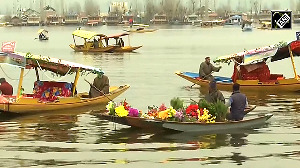In a continuing series on the Sethusamudram Shipping Canal Project, we interview an archaeologist for his views.
We had earlier interviewed world-renowned tsunami expert Dr Tad S Murty and Dr Kalyanaraman, a researcher on the subject, geologist Dr V Badrinarayanan and mariner H Balakrishnan.
Before retiring as the Superintendent Archaeologist of the Chennai region, Archaeological Survey of India, Dr T Satyamurthy was the Director of Archaeology, government of Kerala. He spoke to Shobha Warrier.
The ASI affidavit to the Supreme Court said the Rama Sethu was not a man-made structure. As an archaeologist, do you agree with the affidavit?
I don't know the details of the affidavit as I have not seen it. To my knowledge, no archaeologist has worked there. The National Institute of Ocean Technology has done some underwater work. (Dr Badrinarayanan spoke about that work in his interview to rediff.com). But we have not done any work there.
You mean the archaeological department has not done any excavation work at the site?
So far, they have not done any work there. Some other reports prepared by others are available. Maybe ASI has based their affidavit on them. So, it may not be directly from our source but from some other source they might have gathered information. Without any base, they (ASI) would not have told the Supreme Court whatever they have said.
As an archaeologist, how do you describe Rama Sethu?
At present, I will not say anything but I feel the structure has to be thoroughly re-examined. It is true that some alignment is there. Earlier writers like Pliny in 100 AD had described the pathway in his writings. According to Pliny's description, the water is shallow and the reef is visible. He says there is deep sea in between.
Portuguese and Dutch writers also have written that it was not possible to navigate that way because of the pathway.
In one of your essays, you have written that Romans made use of the pathway to trade with Ceylon (Sri Lanka) from the 1st to 3rd century.
Yes. In the earlier days, Romans could not come round Cape Comerin to come to east coast. They came via the west coast by land or if they were coming by sea, they had to go to some of the south East Asian countries and then come back. They could not come round because of the Sethu. This has been proved by the evidence collected by coins. Roman coins show that early trade was only through South East Asian countries, and not through the Gulf.
Whatever we find in the Mannar region in Sri Lanka is available in Thirunelveli also, and that shows there was trade between Ceylon and India. The trade was possible only because of the Sethu.
Roman and even Sangam age coins can be found in both places separated by the Sethu.
A study conducted by S K Sitramabalam of Sri Lanka found striking similarity between the urn burial site of Pomparippu, south of Mannar and such sites in Madurai, Thirunelveli etc. This shows there are a lot of cultural similarities between Ceylon and South India.
How is it that even during the Iron Age, there was cultural oneness between Sri Lanka and south of India?
That is because of the shallowness of water in the Gulf of Mannar region only. The movement between these two countries was not a problem. That is why during the Iron Age to Megalithic period to pre-historic period to even the Chola period, there is no difference between these two regions culturally.
Whatever materials you find here in Thirunelveli, Adityanallur, etc, you find in Poomparippu in Sri Lanka also. All that is connected with the culture of the Chola period is seen there in Sri Lanka.
It signifies that even in Iron Age and early Historic age, there was movement and that is why there is cultural oneness between Sri Lanka and the south part of India.
You have mentioned about the two temples on either side of the strait; a Rama temple in south India and on the Sri Lankan side, a temple for Mandodari, the wife of Ravana. What do these temples signify?
According to Sri Lanka tradition, Mannar is Mandodari's place. Here in Rameswaram, there is a temple for Lord Rama. According to Valmiki Ramayana also, there is a place called Aadi Sethu in Kodikal and it is believed that Rama wanted to build the bridge there. He found the nautical miles too long from there. Valmiki Ramayana says that when somebody suggested the Mannar area, he came and built the bridge there.
In history, how far can we go back and see references of Rama Sethu?
As far. 2,500 years before Christ. This we can decipher from the writings of Pliny and others. In the Greek writings also, you see mention of the pathway between India and Sri Lanka.
But to prove archaeologically, you have to do studies there. You can make a horizontal digging and find out.
Why were no archaeological excavations done in the area?
Archaeological excavations in the independent India are done only if there is a problem over there. We don't go and dig anywhere.
Do you feel it is worth doing some underwater archaeological studies there?
It is worth doing studies both underwater and onshore also.
ASI had done a lot of excavations in Dwaraka to find out about temples.
That was also a problem oriented survey. That was done when S R Rao found some temples below the present level of the Dwaraka temple. So, he doubted it and did the project. Nobody has undertaken a similar project here. Now, it is the right time (to do so).
How long does it take for a proper study to be conducted in the area?
It will take only six months to do a study. It is not very difficult.
Have the Sri Lankan authorities done any study?
In the last 25-30 years, research work has been completely hampered. So, they are also unable to comment.
Photograph: Sreeram Selvaraj






 © 2025
© 2025